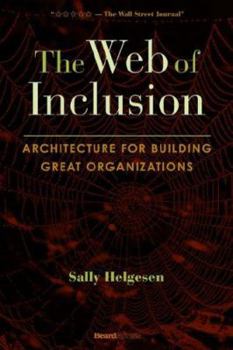The Web of Inclusion: Architecture for Building Great Organizations
Select Format
Select Condition 
Book Overview
The author of the groundbreakingThe Female Advantage,??a revolutionary approach to management for the post-industrial economy. In her highly acclaimed bookThe Female Advantage,??Sally Helgesen showed... This description may be from another edition of this product.
Format:Paperback
Language:English
ISBN:1587982773
ISBN13:9781587982774
Release Date:December 2005
Publisher:Beard Books
Length:320 Pages
Weight:1.15 lbs.
Dimensions:0.7" x 6.0" x 9.0"
Customer Reviews
2 ratings
Worthy Reprint of 1996 Edition--Vitally Important
Published by Thriftbooks.com User , 16 years ago
This wonderful book spans varied literatures including complexity science, organizational intelligence, wealth of networks, and the value of diversity. See also my review of The Difference: How the Power of Diversity Creates Better Groups, Firms, Schools, and Societies. Early note: Web of inclusion is natural adaptation and resilience in the face of the blurring of the lines among organizations and their traditional functions (e.g. governments, corporations, non-profits) *and* the collapse of pyramidal organizations no longer suited for operating in high-speed complex environments. The book is organized into five early to digest pieces: 1) Marketing 2) Diversity 3) Front lines (Rommel's genius was in understanding that the Corporal at the very front who sees a "gap" in enemy lines that can be exploited, is priceless, and should be given virtual command of the platoon, company, battalion, and even division behind him, as he leads a penetration of that priceless gap that allows flanking of the enemy). I emphasize this because this is the difference between failed top-down "command and control" organizations including our failed two-party spoils system, and the new diverse bottom-up "collective intelligence" wealth of networks form of organization and decision-making. 4) Training endemic and continuous. 5) Outside alliances at least as important if not more important than internal organization (all of the Presidential candidates are failing here, but Barack Obama especially so--Naderites, Reagan Republicans, and True Conservatives have been offering to endorse him on New Year's Eve in Iowa and his national and state staffs are literally (I went to Des Moines personally to put a human face on this incompetence) blowing everyone off and focusing ONLY on the door to door tactics, a reprise of the Dean campaigns' implosion). The author adds meat to a clearly understood emerging trend in discussing how existing and emerging information and communication technologies are inherently and profoundly anti-bureaucratic and democratizing. The author cites the Toffler's whose pioneering works include Powershift: Knowledge, Wealth, and Power at the Edge of the 21st Century andthe more recent Revolutionary Wealth: How it will be created and how it will change our lives in discussing how networks not only make possible, but DEMAND and MAKE HAPPEN a redistribution of power (from centralized to decentralized). There is a lovely section of the book on how the Village Voice, a globally respected neighborhood publication was made that way by a man who emphasized listening and asking the right question, over heirarchy and defined functions. INCLUSION was a deliberate strategy. There is a fine section on how women organize as circles, while men prefer pyramids. I have been saying for years that women make better intelligence analysts because they have smaller egos and higher social IQs than men. Although biomimicry is not mentioned, there is an excellent s
Full of ideas about creating fluid, flexible organizations
Published by Thriftbooks.com User , 27 years ago
Helgesen offers both principles and excellent, in-depth case studies of creating fluid, flexible and powerful organizations. She did a masterful job of finding organizations which illustrate differing aspects of "chaordic" organizations (a term coined by VISA founder Dee Hock). If you want to recreate an organization to be values-driven and adapt to ever-changing realities, this is a great resource. Of particular interest is a chapter towards the end on how the physical office space affects an organization. Kudos




